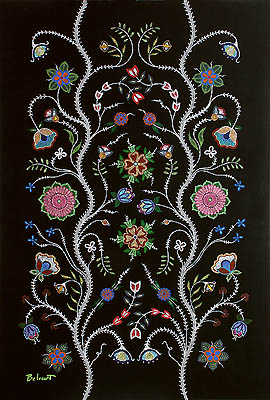Quantifying Phase in Native Knowledge Systems
Recall that the Yupik's yuuyuuk had two balls on strings that moved like mirror images. When one was at 0 degrees, the other was at 180. We call that 180 degrees out of phase. The previous question--how to prevent all the ecological burns from happening at the same time--brings up the concept of phase as well. If I start my two year meadow burn cycle on an even year, and my 8 year bush burn cycle on an odd year, then they will always be “out of phase”, never burning simultaneously. Nature uses a similar trick: cicadas emerge every 13 or 17 years, prime numbers that are hard to synchronize with.
Another way to visualize cycles is with a time series. The Indigenous people of the northeast woodlands (Anishinaabe, Haudenosaunee, Abanaki, and others) are famous for their floral beadwork, often featuring undulating vines, like this image from Christi Belcourt (she uses painted dots to represent the beads). Like most traditional images, multiple species sprout from a single vine. Some plants sprout from cycle peaks, others from cycle troughs. In this simulation, you will use Christi's technique to specify the phase of the cycle for each plant you want to include in your design.

The above is just one part of a larger painting shown below. Notice that the two vines are 180 degrees out of phase, the same “mirror image” effect we saw in the Yupik string game. You can find more about the meaning of this beadwork tradition in the suggested readings section.
